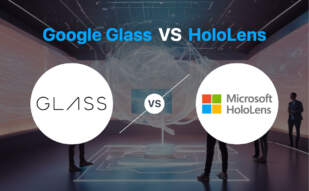
HoloLens
Gracing the digital stage in 2015, Microsoft’s HoloLens has championed the realm of mixed reality, implementing sweeping changes across various sectors, from healthcare to manufacturing and education. Unleashing the potential of human ingenuity, its evolution now sees HoloLens 2 leading the vanguard. It is an enterprise-ready, untethered holographic device that merges data with poetry, intelligence with intuition.
HoloLens Top Features
- Ergonomic and Untethered: unchaining users from the constraints of place and time.
- Built-in Voice Control (Cortana): offering seamless conversations with technology.
- Easy Integration with Microsoft Azure cloud services: sharing the strength of the cloud’s endless computation.
- Biometric Recognition and Eye Tracking: personalizing interactions and increasing usability.
- Immersive Spatial Audio Technology: offering an auditory experience that twines itself to reality.
| Standard Version | $3,500 |
| Industrial Edition | $4,950 |
| Projected AR Market by 2026 | $88 billion |
HoloLens Limitations
- Price Point: making it an investment proposition for many potential users.
- Compatibility: limited to certain (albeit popular) design software and platforms.
- Initial Learning Curve: for optimum utilization of its extensive features.
HoloLens Pricing
The HoloLens standard version is available at $3,500, while its robust counterpart, the Industrial Edition, comes at $4,950.
HoloLens Use Cases
Healthcare
The HoloLens has been embraced in the healthcare sector, with startups like ApoQlar using hologram visualizations to demystify surgical procedures for patients, and MEDIVIS leveraging its features for surgical planning.
Manufacturing and Education
In both manufacturing and education sectors, the HoloLens has found a home. Organizations like Lockheed Martin achieve precision in deep-space vehicle construction, while educational institutions utilize 3D modeling and interactive curricula using HoloStudio.
Remote Assistance and Training
The HoloLens has also provided crucial remote assistance during tough times like the COVID-19 pandemic, with companies like Mercedes-Benz leveraging the technology. Similarly, Microsoft’s contract with the U.S. Army for combatant training demonstrates its applicability for remote and location-independent troubleshooting.
ARCore
Developed by Google, ARCore is a sturdy platform for creating diverse and immersive augmented reality experiences. Building on the pioneering technologies developed for Tango over three years, ARCore operates without the need for additional hardware, thereby facilitating increased accessibility across the Android ecosystem.
ARCore Top Features
- Motion Tracking: Enables the tracking of the mobile device’s position as it moves.
- Environmental Understanding: Assists the device in gauging its surroundings.
- Light Estimation: Empowers photorealistic AR experiences by evaluating the environment’s current lighting conditions.
- Geospatial APIs: Includes the newly introduced Streetscape Geometry API, Geospatial Depth API, and Scene Semantics API.
| Features | Description |
|---|---|
| ARCore Geospatial API | Harnesses the power of Google Maps to enhance AR experiences. |
| Unveiling of new APIs | Introduces innovative features such as remote location AR and public landmarks recognition, increasing the scope of AR applications. |
| Widely Supported | Supported by a wide array of Android phones running Android 7.0 (Nougat) and later, with collaborations in progress with manufacturers like Samsung, Huawei, LG, ASUS. |
ARCore Limitations
- Maps Compatibility: Some users have reported issues with live view compatibility on Google Maps.
- Unauthorized Installation: There have been instances of unauthorized installations of Google apps that have been associated with ARCore.
ARCore Use Cases
Use case 1: App Developers
For those keen on introducing AR elements in their apps, ARCore’s motion tracking and environmental understanding capabilities provide a powerful platform for building immersive experiences.
Use case 2: AR Enthusiasts
AR enthusiasts can appreciate the ability to interact with data-rich and detailed AR projected objects, made possible by ARCore’s light estimation and innovative Geospatial APIs.
Use case 3: Outdoor activities
Whether it’s tourists navigating an unfamiliar city or open-air game players, ARCore’s Geospatial APIs provide detailed, contextual information — essentially transforming the outdoor world into an AR playground.
ARKit
An indomitable solution in the AR landscape, ARKit by Apple has been pushing the boundaries of Augmented Reality since its inception in 2017. Its versatility is backed by continuous evolution with each iOS update, expanding its applicability beyond gaming to industrial sectors, shopping, and more.
ARKit Top Features
- Supports 4K video capture, pivotal in film production, video editing, and social media applications.
- Features high-resolution background image capture coupled with HDR video capability.
- Employs Location Anchors for AR experiences, recently expanded to Montreal, Sydney, Singapore, and Tokyo.
- Boasts robust Motion Capture capability, enabling efficacious capturing of human movements.
- Allows simultaneous use of front and back cameras, paving the way for innovative AR content interaction using facial expressions.
| Scene Geometry | Enables space mapping with helpful labels for identifiable elements like floors and walls. |
| People Occlusion | Allows AR content to interact realistically with people in the physical world. |
| Object Capture & Character Control | Offered as an advanced feature in ARKit 5. |
ARKit Limitations
- Operational efficacy is contingent on optimal lighting conditions.
- Requires a flat surface to employ visual odometry.
- Hardware requirements may be demanding – leveraging the camera, processors, and motion sensors of iOS devices.
ARKit Use Cases
Use case 1 – AR Navigation
ARKit’s potential extends to AR navigation with GPS and Bluetooth beacon integration making it a viable tool for indoor navigation – instrumental in large spaces like shopping malls, convention centers and retail stores.
Use case 2 – Film Production and Social Media
The tool aids in film production and social media applications by providing 4K video capture and high-resolution background image capture, thereby enhancing the visual quality of the content.
Use case 3 – Gaming and Industrial Sectors
ARKit’s sophisticated features like people occlusion, scene geometry, and advanced motion tracking have found uses in gaming and various industrial sectors. Its ability to detect up to 100 images at a time improves physical object recognition in 3D, taking the gaming and industrial AR experiences a notch higher.
Grant Sullivan
Content writer @ Aircada and self proclaimed board game strategist by day, AI developer by night.





